Chihuahua: description, breed types, nature and content
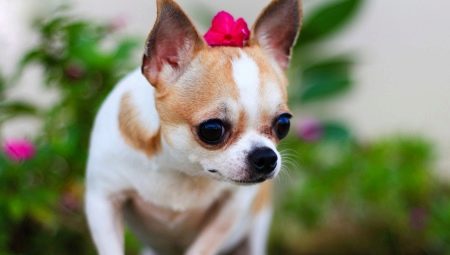
The smallest dog in the world has the world's most famous owners. Chihuahuas are carried in bags by stars such as Madonna, Britney Spears and Paris Hilton.
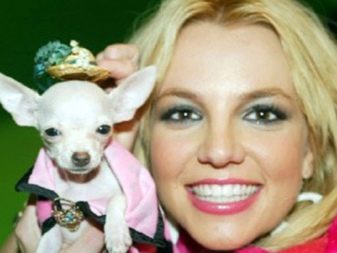
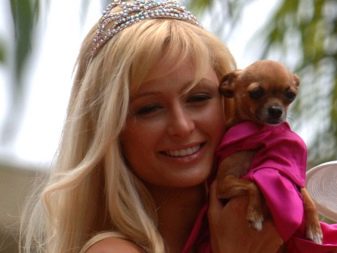
This Mexican purebred dog is more than just a luxurious toy.
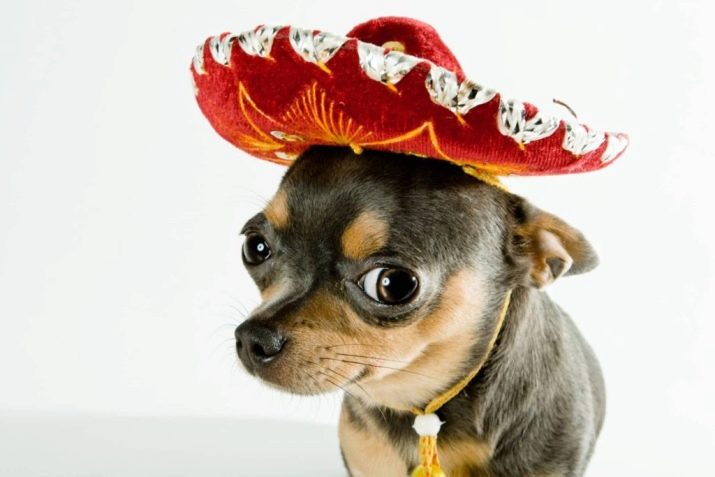
History of origin
While there are various theories about the origins of the Chihuahua breed, it is almost certain that the breed comes from Mexico. In the province of Chihuahua in the north of the country, wild small dogs, reminiscent of purebred Chihuahuas, still live.
According to this theory, Chihuahuas belonged to the sacrificial dogs of the ancient Mexicans. People believed that Chihuahuas were guides of souls to the afterlife, so they were often buried with the dead.
These dogs were sacrificed to the gods in order to gain their favor and provide themselves with protection. In one of the monasteries near Mexico City, there are statuettes depicting Chihuahua puppies.
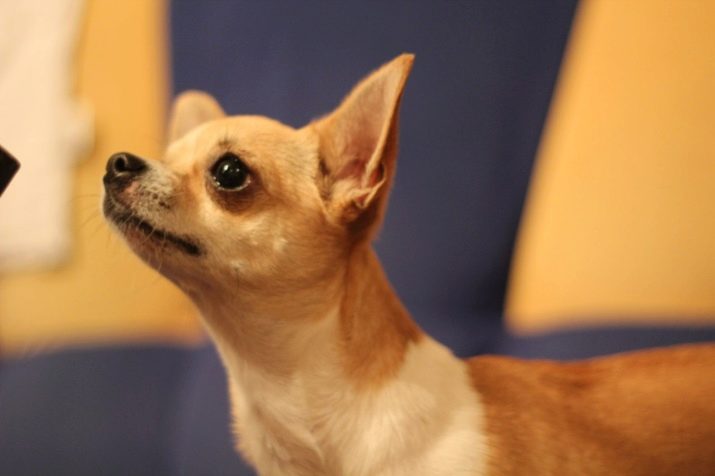
During excavations carried out in the settlements of the Toltecs - ancient tribes that lived in Mexico before the arrival of the Aztecs, many clay and stone figurines were found that resembled Chihuahua dogs. Most of these figures were found on the Yucatan Peninsula in one of the oldest Mayan cities, Chichen Itza. The city was founded around 530 AD. NS. However, the Toltec dogs were larger than the current representatives of the breed.
In 1850, archaeologists discovered the tomb of an Aztec prince in Mexico. A statue of a dog was found in it, which looked very much like a Chihuahua. She pointed out to scientists the sacred past of this breed.

An interesting theory about the origin of this breed was put forward by Czech dog handlers. They claim that in the pre-Columbian period, the dogs that were favorites of the rulers of Prague were sent as gifts to the rulers of Mexico. After acclimatization, they became a Mexican breed and are now returning with a new name to Europe. The fact is that in the Czech Republic, for a very long time, there are small dogs similar to Chihuahuas with an even head.
There is also a theory that the Spaniards brought these animals with them during the conquest of Mexico in the 15th century. However, none of the above theories can be 100% confirmed or completely refuted.
Small dog breeding flourished on the South American continent in the 13th century during the reign of the Aztecs, which almost disappeared after the conquest of Mexico by Cortez in 1520.
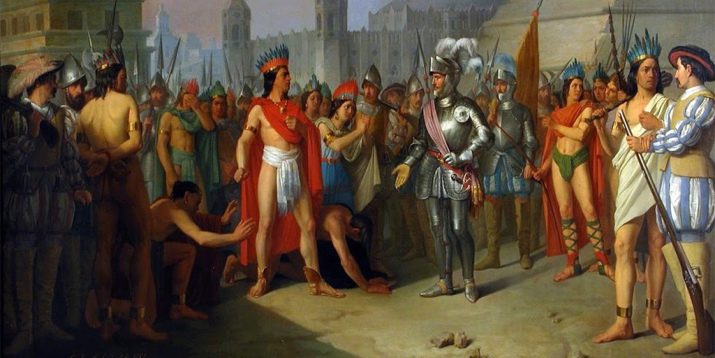
The arrival of the conquistadors of Cortez and the end of the Aztec world were also the end of the Chihuahua world. These dogs survived only because of their intelligence0 of small size and because the invaders did not understand the religious significance of small dogs and did not exterminate them. Only thanks to this, the Chihuahuas remained almost unchanged until the middle of the 19th century.
At that time, farmers in the Mexican province of Chihuahua began to aggressively sell these small dogs to the United States of America. Then their popularity began to spread throughout the world. Tourists were so attracted to small dogs with disproportionately large eyes and ears that they took them with them to all corners of America, as well as to Europe.
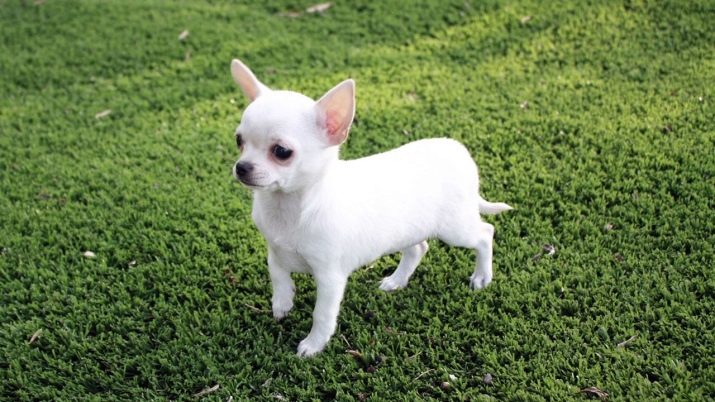
At the beginning of the 20th century, the American Kennel Club developed the first breed standard, and in 1923 the first club of its lovers appeared. To this day, the dogs of this club are the leaders in world breeding.
Chihuahuas appeared on the European continent after World War II. In Germany, the first copies were registered in 1956, in Switzerland and Italy in 1963.
Today Chihuahuas are most popular in France, Germany and Spain. And no wonder, because it is one of the most interesting and very attractive breeds. Chihuahua is the perfect pet. A characteristic feature of these dogs is that they do not bark.

In 1952, the American Chihuahua Club decided to divide the breed into two varieties: long-haired and short-haired. Long-haired Chihuahuas have been crossed with Papillon, Pomeranian and Pekingese. The short-haired species began by crossing with a black-brown terrier. However, to this day, it is allowed to cross these species among themselves. At exhibitions, they are evaluated separately.
Until the middle of the twentieth century, no breeding Chihuahuas were registered in Mexico. They all come from the United States of America.
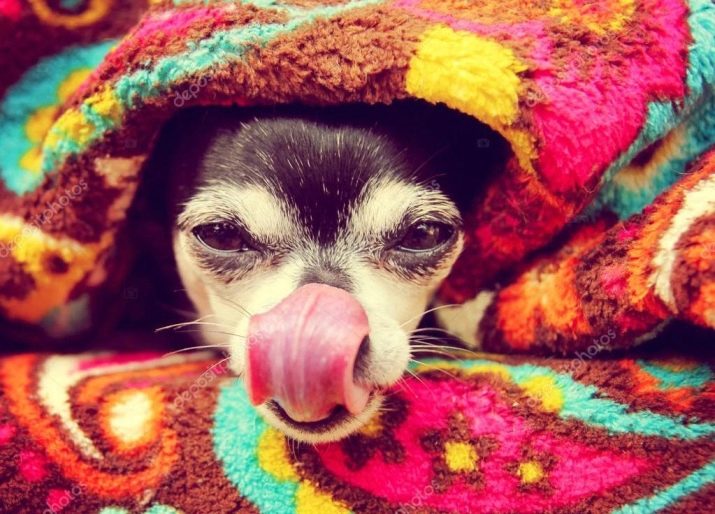
The British Chihuahua Club was founded in 1952. In the beginning, there were 8 dogs in the studbook. But their popularity grew from year to year. The British experimented by adding other breeds to them.
Although this dog is a small breed, it demonstrates a high adaptability to the most extreme climatic conditions. She feels equally well both in hot Mexico and in Canada and the Scandinavian countries.


Description of the breed
Chihuahua is distinguished by an elongated stocky body, a long elastic neck and an apple-shaped head.On her head she has disproportionately large erect ears, on her muzzle there are large expressive dark-colored eyes and an upturned nose, which can be of any color: black, pink or beige. The medium-sized tail is raised or has a curl that almost touches the back. The tail can also be pulled down in a semicircle.
An interesting fact is that the breed standard does not provide specific data on the height of the dog at the withers. It is believed that its height should be no more than 20 cm. The size of the dog is usually determined by weight. The ideal weight for a Chihuahua is 1.5 to 3 kg. There are individuals weighing from 500 g to 1.5 kg. The most popular among the owners are miniature dogs.
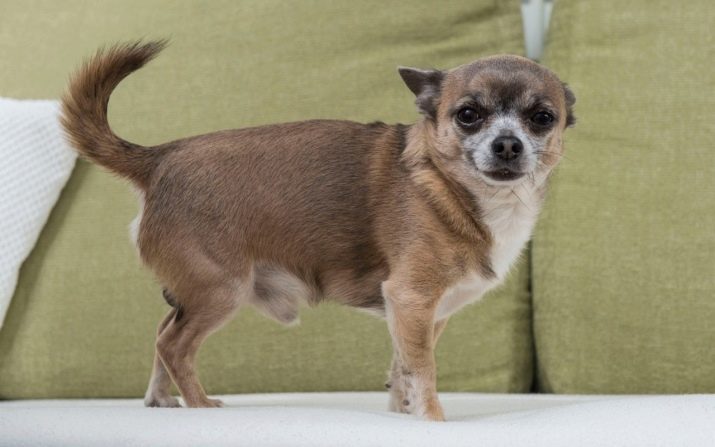
A distinctive feature of the Chihuahua is its very small stature. By comparing the individual breeding lines with each other, you can make sure that it is a very diverse breed, and some of its specimens borrowed a lot from the Pekingese and other breeds.
Female Chihuahuas can be larger and longer than males, which is kind of an innovation among dogs, because it's usually the other way around.
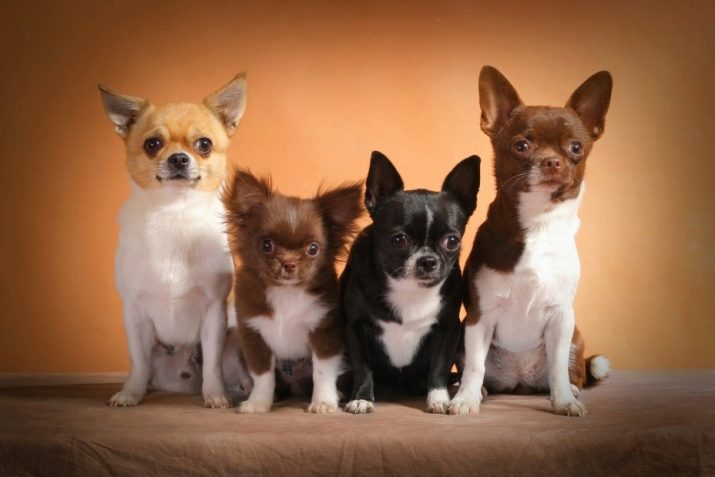
Since Chihuahuas have a small head, their jaws are undeveloped and very weak - this affects the bite. The correct one should be scissor. However, a pincer bite is also common. Recently it became known that the strongest and most reliable grip is still a pincer bite.
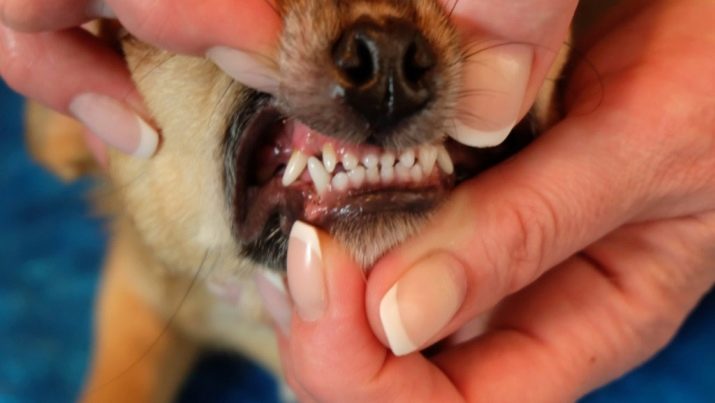
There is also a division of dogs into different colors:
- black monophonic;
- black and white;
- black and tan;
- chocolate;
- tiger;
- sable - light brown or beige;
- purple, blue or reddish.
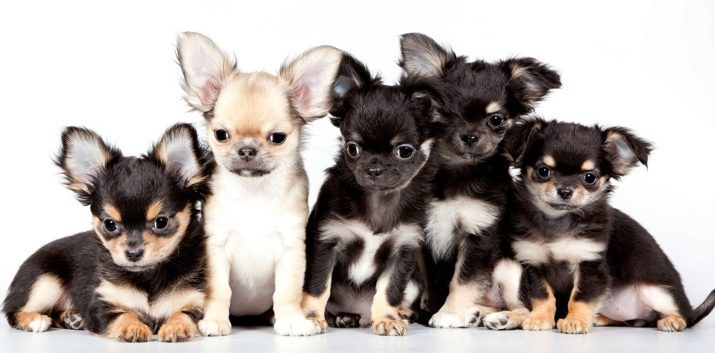
There are no clear requirements for a specific color. Any colors and their combinations are allowed, except marble.
Character
The ego of this little Mexican dog is enormous. These pets are happy to be in the spotlight and often try to attract him with sonorous barking.
Despite the fact that sometimes Chihuahuas tremble, they are quite brave and even aggressive towards other dogs, many times superior to Chihuahuas. This dog tends to overestimate his abilities, but his intelligence and temperament should not be underestimated.
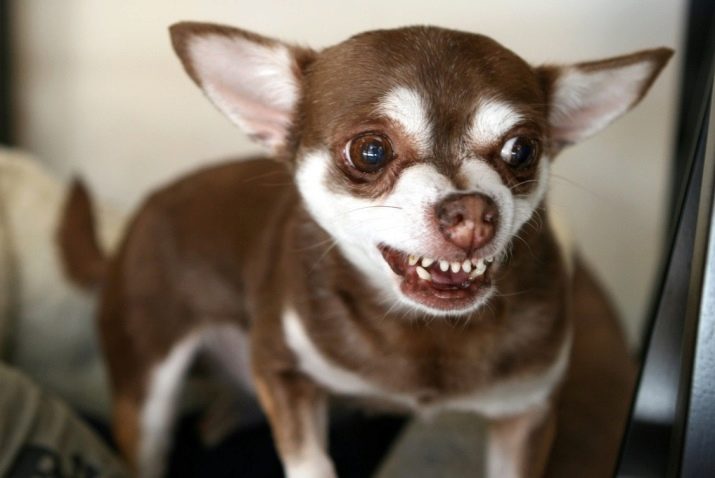
The typical Chihuahua is a brave, sometimes hyperactive, curious, attentive pet. This is a companion dog, she loves to be close to her owner and does not tolerate strangers. Chihuahuas love to play, constant contact with the owner is important for them. In case of danger, these little dogs will not hesitate to protect him, even if they endanger themselves.

Dogs are quite peaceful but they don't have a very good relationship with young children. Chihuahuas try to stay away from them, they do not like noise, rudeness and may even bite a child. If a family with children decides to buy a small dog, it is desirable that the children are of school age.
Dogs of this breed are tolerant of other animals at home, but if the owner pays more attention to them, they will be jealous.
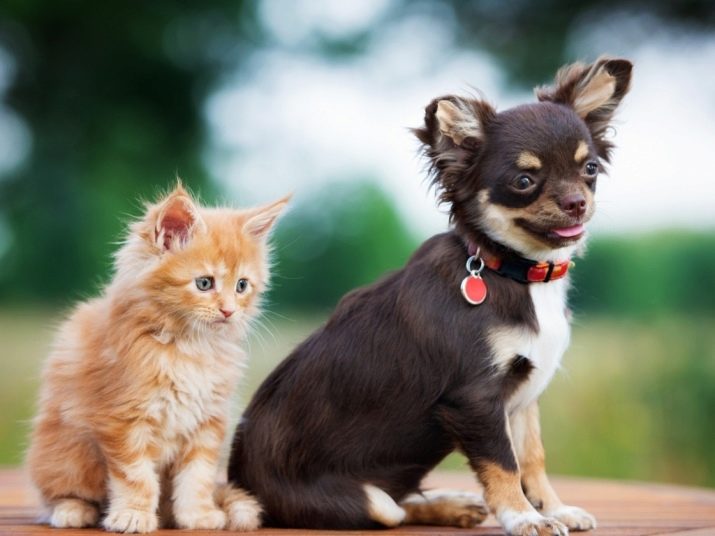
Chihuahuas are quite spoiled pets. But even outside the comfortable bag of the owner, they remain full-fledged dogs that love to run down the street and get acquainted with their surroundings. The exception is rainy and cold weather.
An energetic Chihuahua is recommended professional training. This will help prevent some negative moments, such as a dog's nervous barking or overconfidence and selfishness. In addition, dogs of this breed lend themselves very well to training.
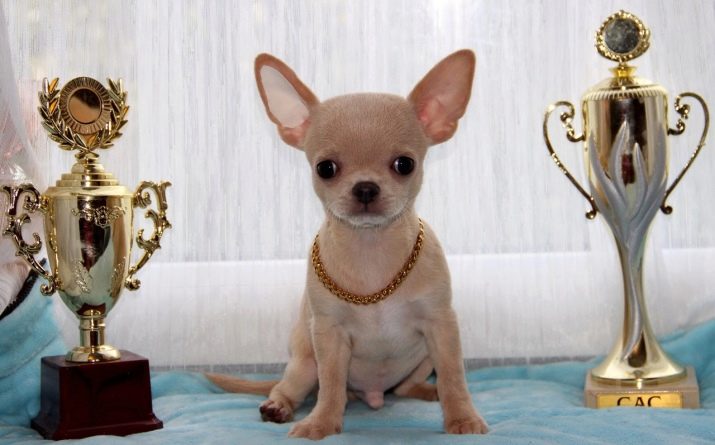
Life span
On average, these dogs live 12-20 years old. Moreover, females, as a rule, live about 1-2 years longer than males.
The lifespan of a Chihuahua is influenced by many factors, such as proper care, the characteristics of the body inherent in this breed, the prevention of injuries (especially the head), and others. In general, Chihuahuas are considered hardy dogs with no major health problems.Under favorable conditions, you can well expect that your little friend will live a long time, at least by dog standards.

However, there are nuances that you should pay attention to in order to increase the life expectancy of pets of this breed.
- A 20-year study of canine mortality found that 18% of Chihuahua deaths were due to with cardiovascular diseases. Although heart disease begins relatively late in a Chihuahua's life (around age 14), it remains a major contributor to the decline in life expectancy in these dogs. The good news is that up to 70% of reported heart disease in this breed is mitral valve degeneration. That is, a disease that can be prevented with proper nutrition and exercise.
- Hypoglycemia - a condition in which blood sugar levels are below normal. Although this is not always immediately apparent visually, hypoglycemia causes a gradual deterioration in physical condition over time. It is very important for dogs to be seen by a doctor when they appear lethargic, sleep a lot, or tend to tremor. Early treatment can stop the onset of this disease. Conversely, if left untreated, the Chihuahua's lifespan will be significantly reduced.
- Other violationsthat can reduce the duration or quality of your pet's life - dislocation of the patella, von Willebrand disease, hydrocephalus and retinal diseases (it is worth taking care of the prevention of eye diseases and prevention of lacrimation in time.)
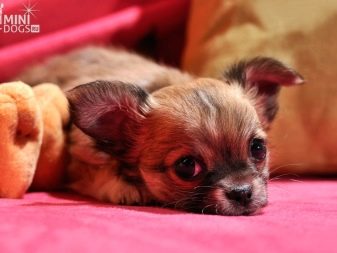
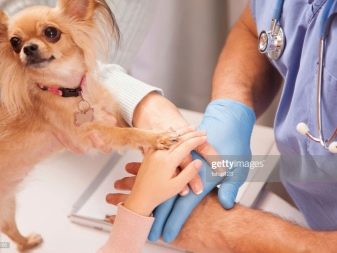
To increase your pet's lifespan, there are several factors to consider.
- A healthy diet is your number one weapon in preventing cardiovascular disease. Chihuahua dogs often ask for delicious "human food". In this case, it is important to be firm. Make sure your little buddy is getting nutritious and well-balanced dog food, and keep excess treats to a minimum.
- Dogs need daily walks. But the distance and intensity should be much less than what is required for a larger dog.
- Due to their diminutive size, dogs may need the help of a veterinarian during childbirth.
- Due to a certain anatomical feature of the structure of the Chihuahua's head, in which many dogs do not completely fuse the skull bones (fontanelle formation), any head injury can lead to sudden death. Therefore, it is advisable to avoid close contact of your pet with larger dogs. Also, do not take the dog to a family with small children. They can accidentally injure the dog.
- Prevention is better than cure. Make sure your furry companion gets a health check every year and that he gets all vaccinations (vaccinations against leptospirosis, parvovirus, and canine flu are especially important).
- Chihuahuas are prone to dental problems. Persistent oral health problems can lead to infection and, as a result, increase the likelihood of fatal diseases.
- Finally, sterilization has many benefits. It lowers the risk of cancer, reduces aggressiveness, and minimizes the chances of your dog running away from home.

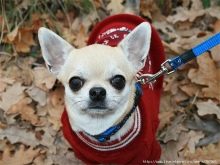

With proper care, the average lifespan of a Chihuahua dog is quite long. Your little pet has a very good chance of longevity, but that depends primarily on you.
Varieties
As mentioned above, there are long-haired and short-haired Chihuahuas. The long-haired has soft, long hair, smooth or slightly wavy, hairy ears and a drooping tail.
The short-haired Chihuahua has short, thick fur that fits gently to the body. There is even an individual so short-haired that it can look like bald.

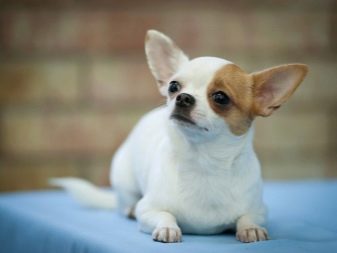
Often there are mixed types, in which it is not easy to determine which species the dog belongs to.However, they also have all the characteristics of the breed and are worthy of the love of their owners.
The deer-headed Chihuahua is a Deer, a somewhat less popular breed. The head of such a dog is elongated, the muzzle is narrower. In addition, the dira body is relatively elongated. Unlike their counterparts, these dogs have longer limbs. It is also important that Dirs have fewer genetic problems than other subspecies of the breed. This makes them the healthiest dogs of all Chihuahuas.
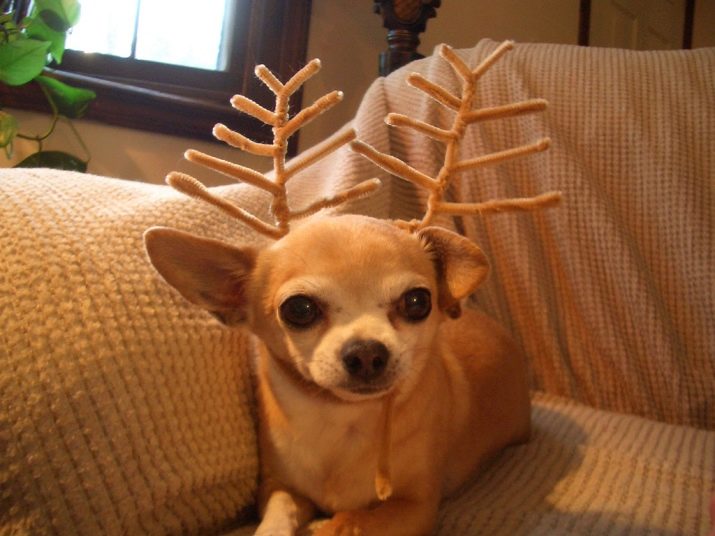
The apple-headed Chihuahua gets its name from the shape of the skull, which resembles an apple. Such Chihuahuas are most often taken as a pet. At shows, a well-defined rounded apple-shaped head is the main requirement for the breed, which is considered when determining the true representative of the Chihuahua. Like most species of this breed, their coat color varies.

Dogs of this subspecies often suffer from hydrocephalus. Their eyes seem to bulge out of their sockets. If you are planning to purchase such a dog, be sure to check if it has hydrocephalus.
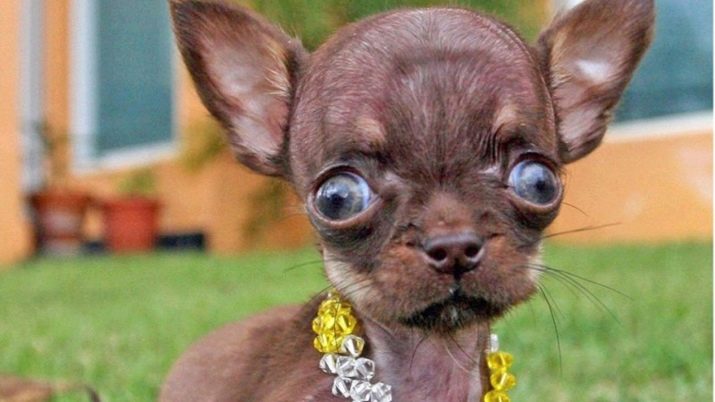
One of the exotic subspecies is the so-called "Dog in a cup". This category includes Chihuahuas that are less than 23 cm long and weigh less than 2.3 kg. This dog looks and behaves just like its larger brethren. The only thing that sets it apart is its size.
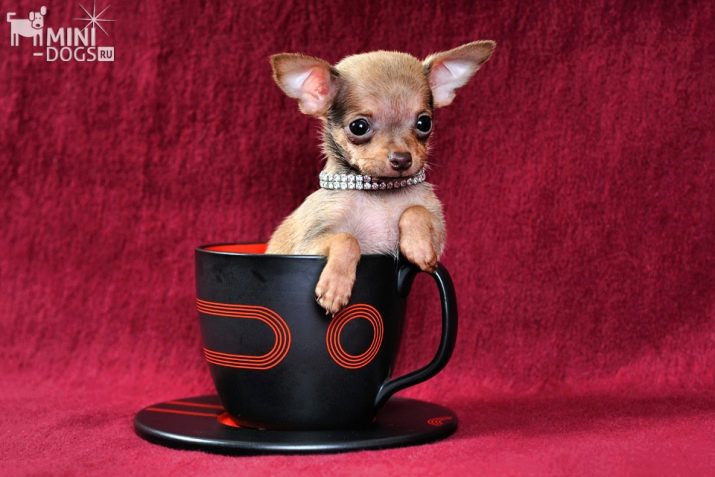
The importance of belonging to a particular species is determined only from an economic point of view, because in our country short-haired Chihuahuas are less common and, therefore, more expensive (on average by about 10-30%). If you want just such a dog, then it will be much more profitable to purchase it from a foreign breeder.
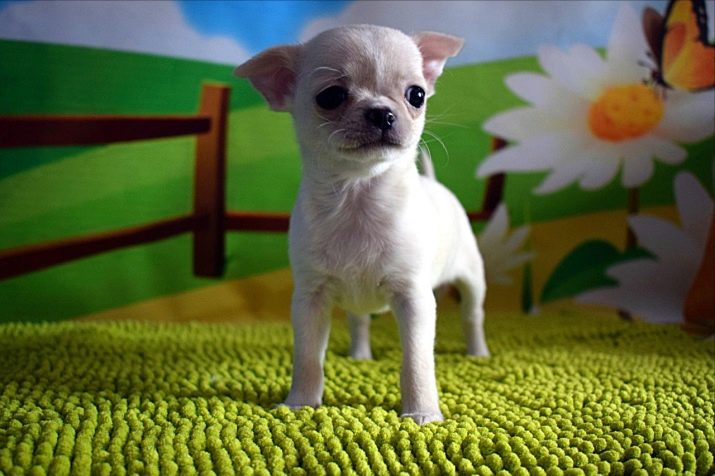
Content
Nutrition
Manufacturers offer a wide variety of dog food. There are dry and wet food, food for puppies and adult dogs. You can buy regular, organic or gluten-free food. Also, the choice is represented by special feeds that take into account the characteristics of the animal's health.
Finding the best food for your dog among the many available options is no easy task. The harder it is because not every Chihuahua will be able to eat the same. After all, an appropriate diet consists of many factors, such as age, weight, physical activity level, gender, and the health of the dog.

The first factor that determines the quality of food is ingredients indicated on the label... Good food should be high in animal protein and therefore meat. After all, even such a small dog is primarily a predator. Its digestive system is adapted to digest meat and bones.
Also, raw meat is easy to digest. The grain components of the dog are difficult to digest, especially in large quantities. What's more, wheat is a common cause of allergies in dogs. Also in Chihuahua food there should be no sugar.
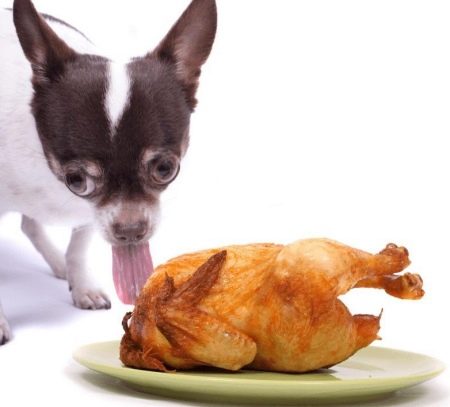
Other important ingredients are vegetables that are essential for your dog to get vitamins... When choosing a feed, you should pay attention to the given values of vitamins and minerals. Often, manufacturers supply their food with extra servings of vitamins, which can lead to overdose.
Dry food is more economical and contains less fat than wet food. Wet food may contain more preservatives, but it also contains more moisture, so when feeding dry food, you should pay special attention to the Chihuahua's drinking regimen.
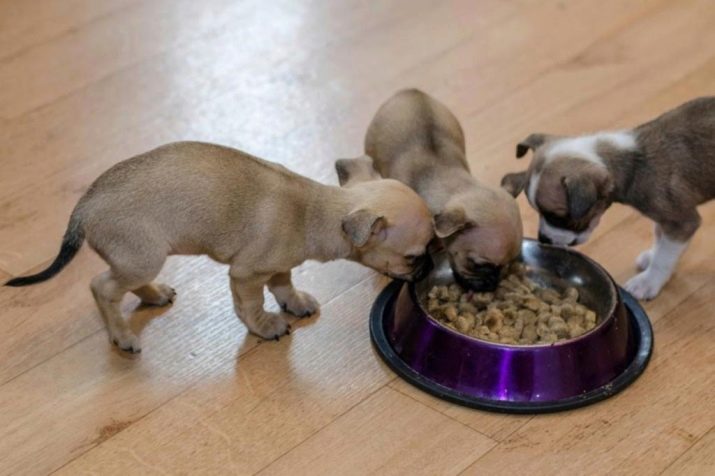
It makes more sense to combine dry and wet foods in your dog's diet, but not during one meal. Your dog digests wet and dry food at different rates, and the combination can cause stomach upset.
A good alternative can be fresh raw meat and vegetables... Their advantage is that they contain all natural vitamins and minerals that are often lost during the production of conventional foods.
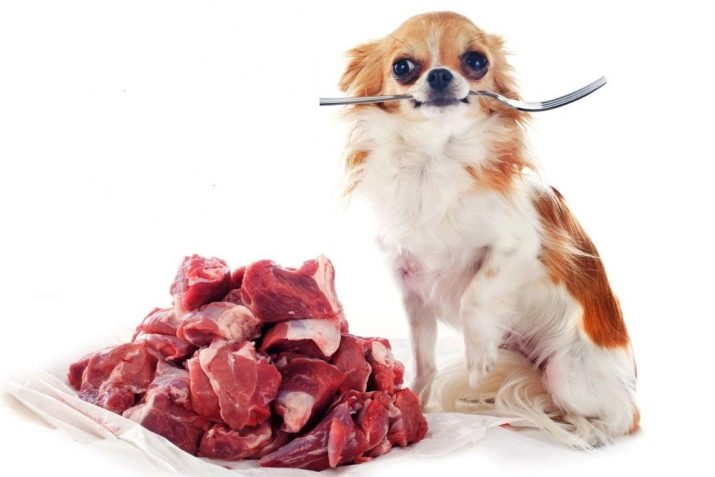
The type and type of food should be chosen based on the individual needs of the pet and the conditions of its daily life. If in doubt, it is advisable to consult with the breeder or veterinarian.
Health
Chihuahuas are considered to be dogs that are hardy and do not have major health problems. However, there are some nuances that you should pay attention to.
- One of the features of this breed is its characteristic body tremor. It occurs in both long-haired and short-haired dogs, although they are not prone to colds.
- Due to their small size, dogs need the help of a veterinarian in the field of obstetrics.
- Another feature is that the fontanel does not overgrow for a long time in dogs. A soft hole tends to heal with age, but requires a lot of attention and care.
- It is worth taking care of the prevention of ophthalmic diseases, as well as to prevent the appearance of lacrimation in time.
- It is also necessary to monitor the growth of teeth in young dogs and prevent the formation of tartar.
- Caring for a long-haired Chihuahua requires regular brushing. Brushing short coats can be limited to occasional brushing with a rubber brush. It is also recommended to bathe your dog with a special shampoo several times a year or as the coat gets dirty.
- Dogs of this breed are genetically prone to neurological and anatomical abnormalities (patellar dislocation). It is necessary to supervise the dog while walking.
- Due to their low body weight, the nails do not wear off as quickly as they should. Claws should be trimmed once a month.
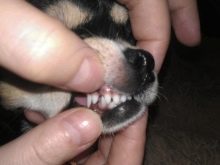
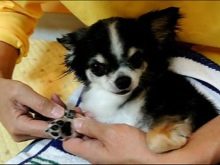

Despite their diminutive size and apparent fragility, dogs are distinguished by good health and disease resistance. They often live up to the age of 16. On average, their life expectancy is 10 - 18 years. -
To maintain your dog's health, it is advisable to have it regularly examined by a veterinarian.
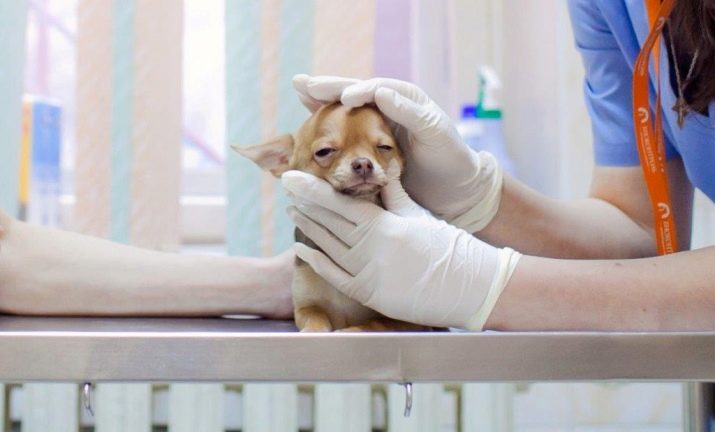
Living conditions
Chihuahua is a dog that is not adapted to life on the street. She feels better at home. Therefore, in cold weather, it is necessary to put on, for example, a sweater. Due to its size, do not leave it unattended in open areas as it may become prey to other animals. And if you don’t muzzle your dog, then a collar with a leash is a must.

Chihuahuas do not like moisture. Baths can be organized for them several times a year, but it is also necessary to take into account the individual characteristics of the dog (the tendency to wallow in the mud). For the bath, use special shampoos for short-haired or long-haired dogs, which are usually recommended for the Chihuahua breed.
Due to their low body weight, their nails do not wear off as quickly as in other breeds. But it is still necessary to trim too long claws. This procedure improves the running comfort of the dog.
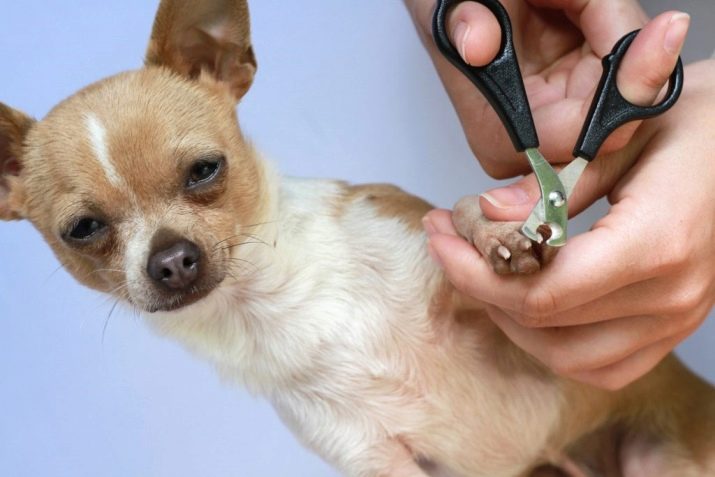
Training
All reputable trainers agree that Chihuahuas are as trainable as other dogs. They are very intelligent, curious, and enjoy the learning process. Especially if you take into account that the classes are held in the company of your beloved owner.
For good training results and satisfaction from the process it is necessary to take into account the characteristics of this breed. For example, the size of the dog, character, age. You should also follow the pet's daily regimen.
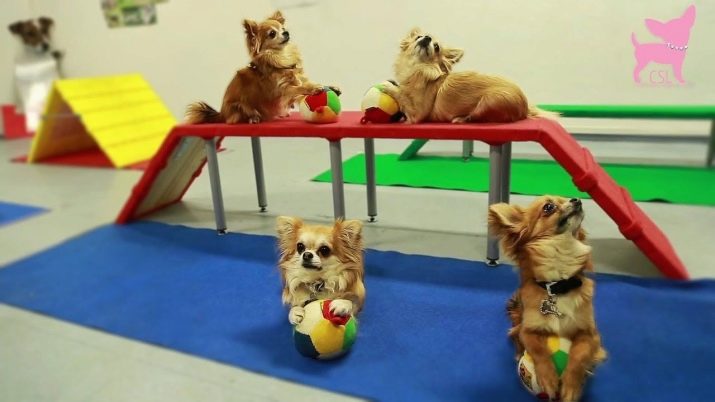
Working with your dog while learning new skills is a great way to connect and strengthen your relationship. Further training in simple tricks will further strengthen this connection.
It has been proven that Chihuahuas can easily perform the same tricks as larger dogs. To teach a Chihuahua to sit on command, give a paw (say hello), roll over, you need sufficient practice and patience. She may well learn a much longer list of tricks.

The main thing is to start training gradually, with simple tasks. First, you need to teach the Chihuahua how to do simple tricks. This will lay the foundation for more complex teams and for a stronger relationship with them. Chihuahuas are often underestimated due to their size, but they are incredibly smart and love to work for a treat.
Before doing any simple tricks, you need to make sure that the dog is already capable of simple obedience, for example, the command "sit", "place" and "come to me." Without these basic skills, it will be difficult for a Chihuahua to learn how to perform more complex tricks.

Show your dog how to do something in a playful way. This can be done by rewarding good behavior and performing the trick with a tasty treat. The optimal training time for a puppy should not exceed 15 minutes.
Having mastered basic obedience principles such as "Sit", "place" and "lie down", Chihuahua is ready to learn other simple commands. You can start with just about any trick, but give your paw, spin, and crawl are some of the funniest.

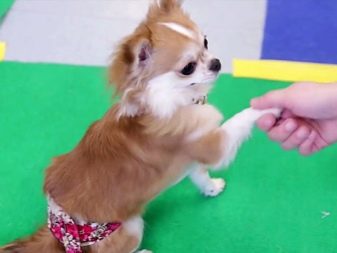
To get started, you don't need too much, just have:
- quiet place to work;
- delicious training treats for dogs;
- a word for praise, such as "well done" or "yes";
- a little patience.
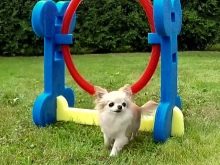

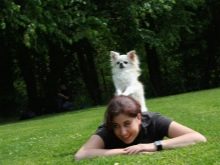
If you take an adult dog into your family, you need to take into account many factors. Perhaps the Chihuahua has never studied in a previous home, or she may have bad habits. Dogs can be cunning and hide their "troubles" if they have been severely punished in the past. Or, conversely, they can indulge in shamelessly right in front of the new owners, if the previous owner never taught them.
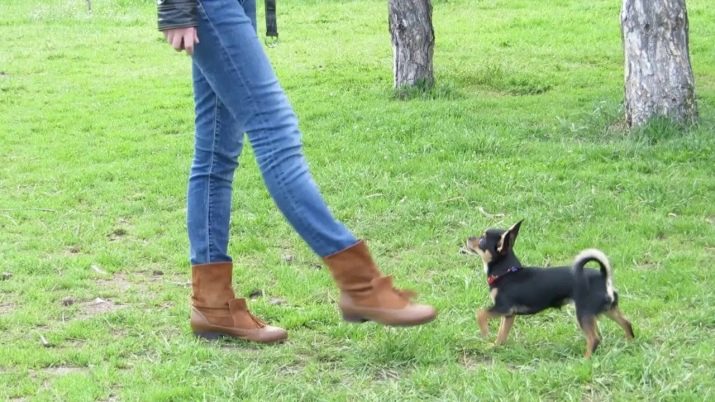
Rewarding implies something good for the little puppy doing the right thing and ignoring bad behavior. Chihuahuas pay close attention to their owners' reactions and are more likely to repeat an action if they receive a lot of praise and love for it.
When a toddler is on the street going about his business in a suitable place, you need to praise him right away. Timing is very important, so it's not a good idea to praise too early or too late. As soon as the Chihuahua finishes his business, you need to praise and pet him. He will begin to associate verbal praise and physical affection with going outside. Since the baby wants to make his owner happy, he will try to repeat this action.
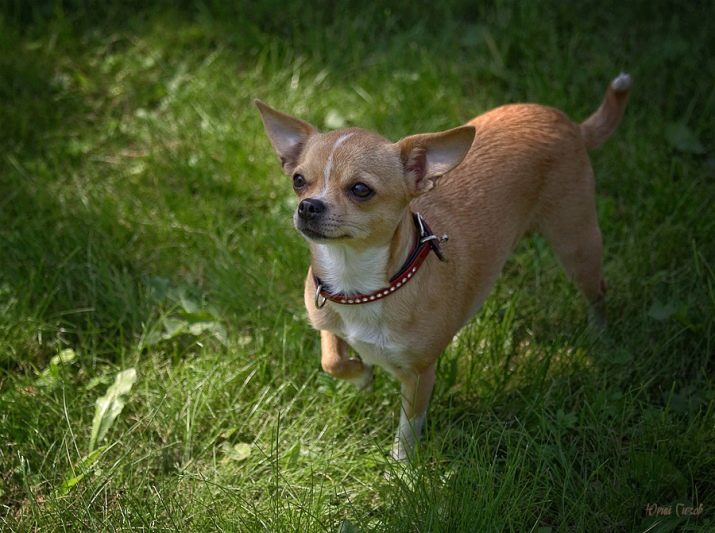
Some trainers offer treats to dogs during litter training, but this is not always a useful Chihuahua training strategy. Even if edible treats are a form of reward, your dog may begin to associate food with going to the bathroom or refuse to use the toilet in the right place without a treat.

Breeding
The Chihuahua's unique appearance - its small size and more proportionately large head - has made it popular all over the world, but has also caused some health problems.
Breeding, which determines the health of dogs, often aimed at creating individuals with even larger ears and a shorter snout, which led to increased sensitivity of the eyes, breathing problems and teething.

Other health problems came from breeders trying to keep dogs smaller and smaller. Individuals weighing only 500 grams cannot protect themselves from infections or other diseases, while ordinary Chihuahuas are naturally resistant, as evidenced by the fact that they survived on the streets of Mexico.
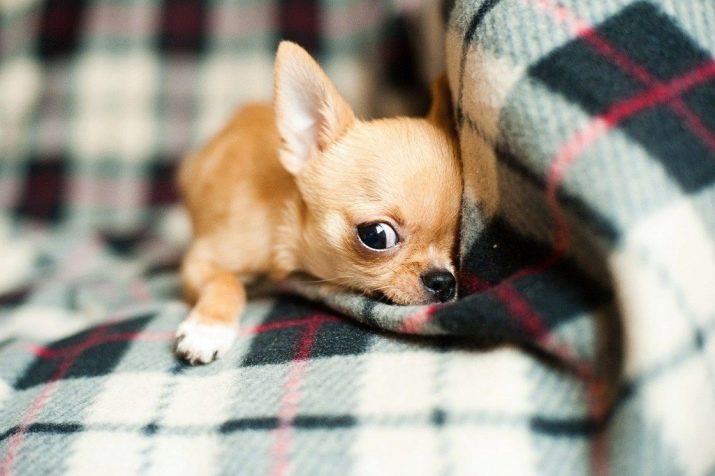
Unnaturally small members of the breed often get sick and die prematurely. Even seemingly invisible viral diseases such as diarrhea or vomiting can endanger the life of such a dog.
Chihuahuas are still the trendy dog to carry around in your purse. Therefore, there are still non-professional breeders looking for quick profits.
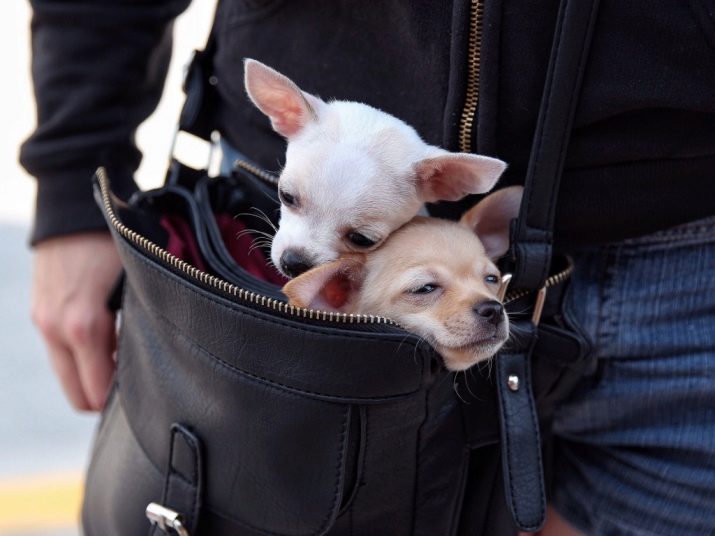
Failure to comply with breeding rules and refusal to prevent diseases lead to the reproduction of the Chihuahua breed with hereditary diseases.These include congenital malocclusion, premature tooth loss, heart valve problems, hydrocephalus, or patellar dislocation.
To reduce the risk of these diseases to a minimum, a potential buyer of this breed should be interested in purchasing it only from a certified professional breeder. She will have all the pedigree documents and all the necessary vaccinations. It should be understood that the prices of purebred dogs, especially the Chihuahua breed, are high - serious breeding entails a lot of costs.

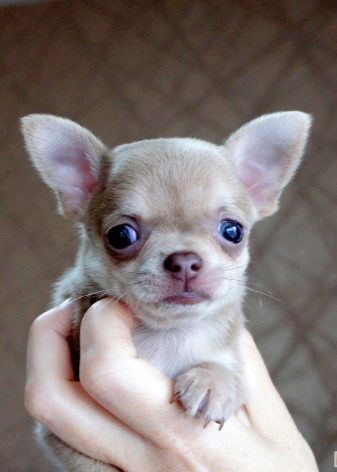
However, investing in a puppy from a good kennel is usually beneficial as it prevents possible subsequent costs of treatment and, of course, the suffering of the pet. It is also a guarantee of many years of joy from being in the family of such a cute pet. A professional breeder with extensive experience is always ready to advise the owner.
Today you can buy Chihuahuas short-haired and long-haired. Long-haired Chihuahuas are twice as numerous as short-haired dogs, despite the fact that the latter is considered to be more resilient and robust.
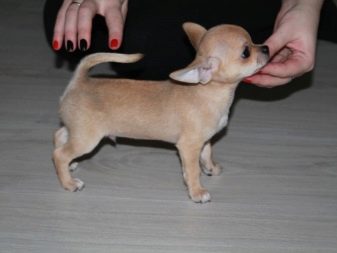
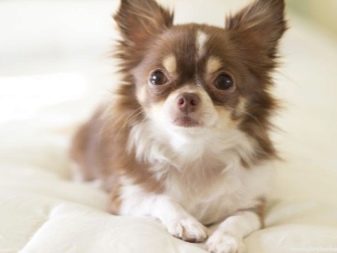
Each specific breed of dog has its own characteristics that a breeder should be aware of before participating in a breeding program. Chihuahua is a very popular dog breed, therefore it requires a lot of care and knowledge.
It is the responsibility of the breeder to follow best breeding practices for Chihuahuas in order to select the best of the breed.
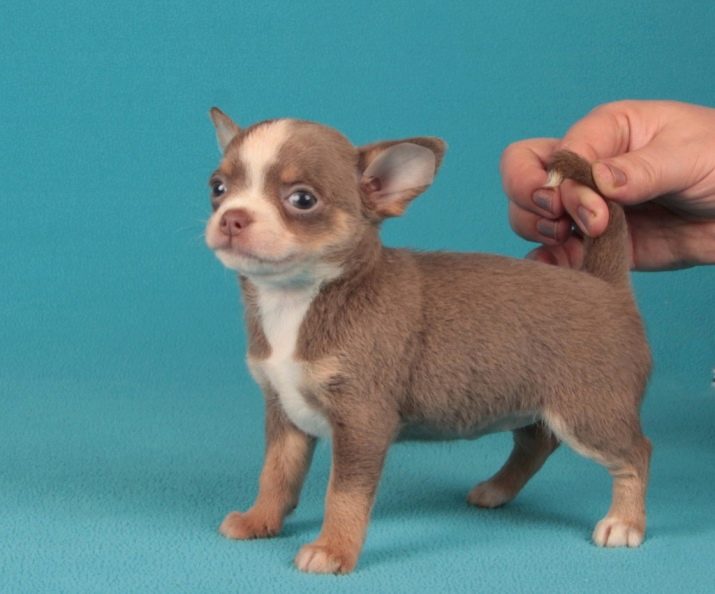
One of the scientific articles described that some of the ancestors of the Chihuahua had a head resembling a deer, while others had apple-shaped skulls. Some breed lovers have also hypothesized that the Chihuahua's "deer" head may be due to the crossing of a Chihuahua and a Chinese Crested dog. Modern breeders focus on apple-headed Chihuahuas, as this type is being popularized and recognized by the American Kennel Club.

The Chihuahua breed, like other miniature dogs, tends to mature earlier than the larger breeds. Typically this is around 6 months of age. As with any breed, female Chihuahuas should never be divorced in their first two or three estrus because their fertility is then not high enough for a successful pregnancy.
Frequent crossing of dwarf dogs is not recommended, since the body of a small female is not hardy enough to cope with frequent pregnancies. It is important to take pauses so that the dog's body is strong enough.
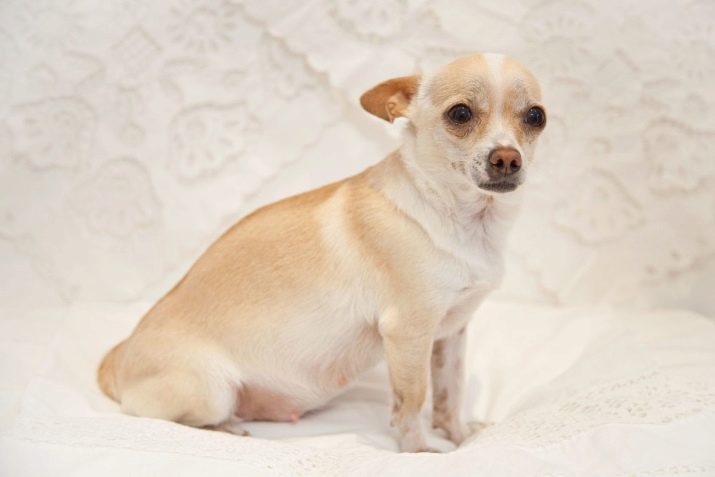
Male Chihuahuas should be used for breeding as soon as they are fully mature - usually one or two years old. It is worth waiting for the puppy to be fully grown to see if it is a good example to use in breeding.
The average litter size of Chihuahua puppies is 1 to 3 puppies. Rarely, a bitch of this breed gives birth to more than 4 puppies.
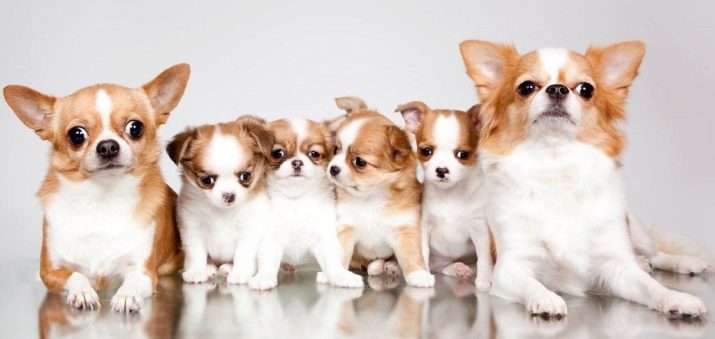
To guess how many puppies a Chihuahua can bring, you need to understand that in dogs, litter size depends on many factors: fertility and female size, male sperm quality, diet, health, etc.
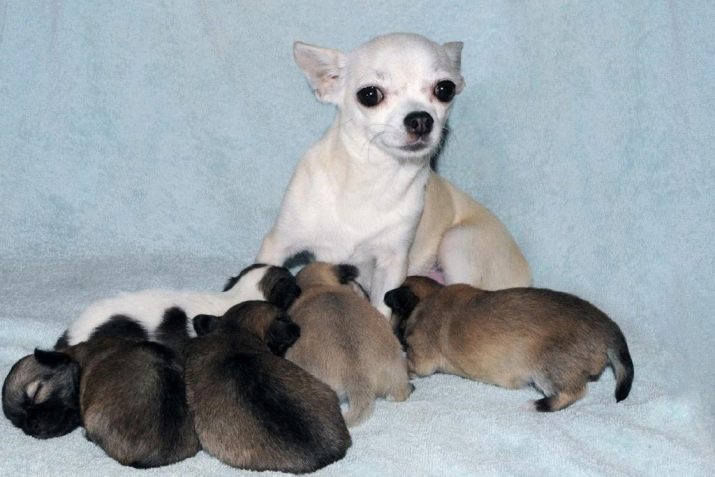
Although Chihuahuas tolerate pregnancy and childbirth fairly well, they may require obstetric care. Despite the fact that newborn puppies are very small, there are certain structural features of the female's body. It's related with the tiny size of a dog's pelvis. In addition, a very small Chihuahua uterus may not expand enough during labor, so an emergency caesarean section may be required.
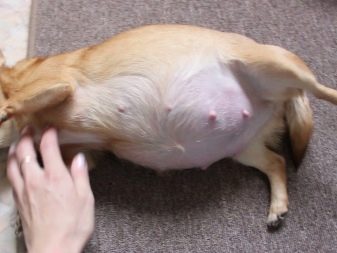
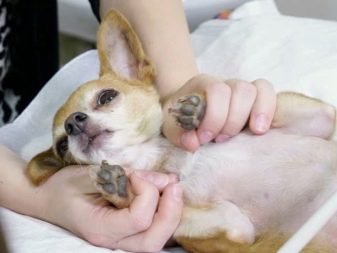
It is important to agree in advance with your veterinarian about a possible operation. In most cases, especially with a small number of puppies expected at birth, a natural birth will take place without problems, but it is the breeder's job to prepare for unusual situations.
It is important that both dogs are completely healthy before mating. Dogs should not have pathologies, chronic diseases. You need to make sure they are up to standard.
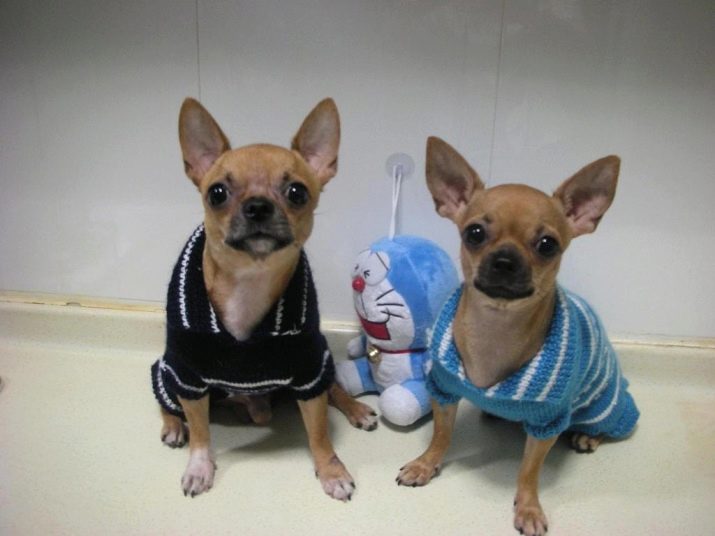
Popular nicknames
Choosing a name for a dog is very important to its owner. Dogs are often given names from cartoons, films, TV series and books - Astra, Beethoven, White Fang, Thug, Droopy, Eddie, Goofy, Lucky, Hooch, HuckelbErry, Fan, Lampo, Lassie, Madison, Odie, Pankracy, Lightning, Pluto, Rex, Ren, Rin, Tin, Saba, Scooby Doo, Snoopy, Football, Bib, Toto, Tramp.
Many take the names of famous dogs - Balto, Barney, Barry, Benji, Boo, Boss, Dyok, Volna, Laika, Snoppy.

Chihuahua nicknames are often given as follows: Fafik, Bubble, Bambi, Amor, Bucks, Coco, Mick, Booba, Posy, Timon, Pimpek, Rocky Nurja, Mickey, Ada, Gloria, Linda, Silva, Elsa, Tina Pozi.
For puppies girls take the following nicknames: Punya, Bella, Belle, Blueberry, Snowflake, Luna, Selena, Pusya, Fiona, Star, Violuna, Nika, Fredzia, Juli, Tuptusia, Nana, Reika, Sweet, Dzyunya, Amy, Mika, Bobusia , Lola, Kitka, Sue, Sarah.
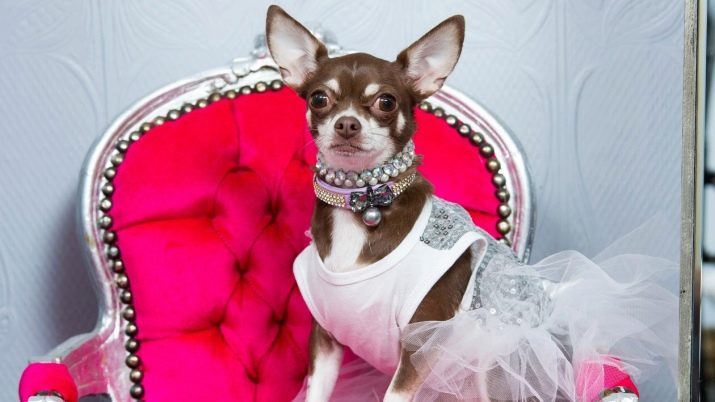
For puppies for boys - Rocky, Mel, Nor, Fresh, Megan, Jin, Kesha, Britt, Brut, Gab, Sab, Busya, Funia, Rusiy, Savaliy, Jess, Bert and others.
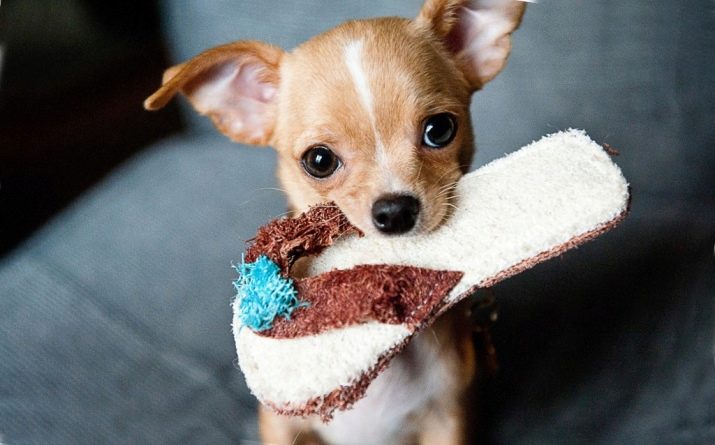
Of course, there are no hard and fast rules when choosing a name for your new friend. It is desirable that it be laconic, sonorous and reflect the individuality of the dog.
Owner reviews
According to the owners, Chihuahuas are very active, self-confident and cocky dogs who often try to show their courage while walking.

Some believe that this breed has no shortcomings, others think that loud barking, hyperactivity, aggressiveness are its main shortcomings.

Yet most owners agree that Chihuahuas:
- dogs that do not require special care, but need constant attention;
- very unpretentious and comfortable breed, you can carry it with you everywhere;
- it is a wonderful pet and loyal friend who is ready to follow its owner wherever;
- it is a very intelligent, playful and affectionate dog that loves to learn new things.



For 10 interesting facts about the Chihuahua breed, see the video below.






































